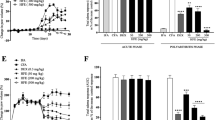Abstract
The present study was carried out to investigate the effects of catechin on adjuvant arthritis (AA) in the rat and its possible mechanisms of action. AA was induced by metatarsal footpad injection with complete Freund’s adjuvant in male Sprague-Dawley rats. The secondary inflammatory reaction was evaluated through assessment of hind paw swelling, polyarthritis index, and pain response. Proliferation of synoviocytes and the activity of interleukin-1 were examined by 3-(4,5-dimethyl-thiazol-2-yl)-2,5-diphenyltetrazolium bromide assay. Tumor necrosis factor-α, prostaglandin E2 (PGE2), and cyclic adenosine monophosphate levels in synoviocytes were measured by radioimmunoassay. The PGE2 receptor, EP2, was analyzed by Western blot analysis. Intragastric administration of catechin (60 and 120 mg/kg) significantly suppressed secondary inflammatory paw swelling, pain response, and polyarthritis index. It also inhibited production of interleukin-1, tumor necrosis factor-α, and PGE2 and increased cyclic adenosine monophosphate levels in rats with AA. In the immunoblot analysis, catechin could upregulate expression of EP2 in the synoviocytes of rats with AA. The results showed that catechin reduced secondary inflammation in rats with AA; this outcome reflects its ability to mediate cAMP levels, upregulate expression of EP2, and inhibit secretion of proinflammatory cytokines in rats with AA.
Similar content being viewed by others
References
Jacobson PB, Morgan SJ, Wilcox DM, et al. A new spin on an old model: in vivo evaluation of disease progression by magnetic resonance imaging with respect to standard inflammatory parameters and histopathology in the adjuvant arthritic rat.Arthritis Rheum. 1999; 42: 2060–2073.
Gao HY, Wu B, Li W, Chen DH, Wu LJ. Chemical constituents ofChaenomeles sinensis (Thouin) Koehne.Chinese J Nat Med. 2004; 2: 351–353.
Feng WY. Metabolism of green tea catechins: an overview.Curr Drug Metab. 2006; 7: 755–809.
Jin Y, Zhao YQ, Ni CL. Chemical constituents ofAcacia catechu (L.f) wild.Chinese Tradit Herb Drugs. 2005; 36: 790–792.
Liu XQ, Li WW, Sheng KX, Liu J, Chen FK. Studies on the chemical constituents of the n-Buoh extract of Polygonum bistorta.J Shenyang Pharmaceut Univ. 2006; 23: 15–17.
Haqqi TM, Anthony DD, Gupta S, et al. Prevention of collagen-induced arthritis in mice by a polyphenolic fraction from green tea.Proc Natl Acad Sci U S A. 1999; 96: 4524–4529.
Adcocks C, Collin P, Buttle DJ. Catechins from green tea (Camellia sinensis) inhibit bovine and human cartilage proteoglycan and type-II collagen degradation in vitro.J Nutr. 2002; 132: 341–346.
Ahmed S, Wang N, Lalonde M, Goldberg VM, Haqqi TM. Green tea polyphenol epigallocatechin-3-gallate (EGCG) differentially inhibits interleukin-1β-induced expression of matrix metalloproteinase-1 and -13 in human chondrocytes.J Pharmacol Exp Ther. 2004; 308: 767–773.
Wei W, Chen MZ, Xu SY. Pharmacological effects of isoxicam.Chinese Pharmacol Bull. 1986; 2: 29–34.
Chen Q, Wei W. Effects and mechanisms of glucosides ofChaenomeles speciosa on collageninduced arthritis in rats.Int Immunopharmacol. 2003; 3: 593–608.
Pezet S, Onteniente B, Jullien J, et al. Differential regulation of NGF receptors in primary sensory neurons by adjuvant-induced arthritis in the rat.Pain. 2001; 10: 113–125.
Dai M, Wei W, Shen YX, Zheng YQ. Glucosides ofChaenomeles speciosa remit rat adjuvant arthritis by inhibiting synoviocyte activities.Acta Pharmacol Sin. 2003; 24: 1161–1166.
Müller-Decker K, Scholz K, Marks F, Fürstenberger G. Differential expression of prostaglandin H synthase isozymes during multistage carcinogenesis in mouse epidermis.Mol Carcinogen. 1995; 12: 31–41.
Roubenoff R, Freeman LM, Smith DE, Abad LW, Dinarello CA, Kehayias JJ. Adjuvant arthritis as a model of inflammatory cachexia.Arthritis Rheum. 1997; 40: 534–539.
Taylor PC. Anti-tumor necrosis factor therapies.Curr Opin Rheumatol. 2004; 13: 164–169.
Dayer JM, Feige U, Edwards CK 3rd, Burger D. Antiinterleukin-1 therapy in rheumatic disease.Curr Opin Rheumatol. 2001; 13: 170–176.
Ben-Av P, Crofford LJ, Wilder RL, Hla T. Induction of vascular endothelial growth factor expression in synovial fibroblasts by prostaglandin E and IL-1: a potential mechanism for inflammatory angiogenesis.FEBS Letters. 1995; 372: 83–87.
Amano S, Naganuma K, Kawata Y, Kawakami K, Kitano S, Hanazawa S. Prostaglandin E2 stimulates osteoclast formation via endogenous IL-1β expressed through protein kinase A.J Immunol. 1996; 156: 1931–1936.
Mauviel A, Halcin C, Vasiloudes P, Parks WC, Kurkinen M, Uitto J. Uncoordinated regulation of collagenase, stromelysin, and tissue inhibitor of metalloproteinases genes by prostaglandin E2: selective enhancement of collagenase gene expression in human dermal fibroblasts in culture.J Cell Biochem. 1994; 54: 465–472.
Dumont JE, Jauniaux JC, Roger PP. The cyclic AMP-mediated stimulation of cell proliferation.Trends Biochem Sci. 1989; 14: 67–71.
Yamada T, Terada Y, Homma MK, et al. AVP inhibits EGF-stimulated MAP kinase cascade in Madin-Darby canine kidney cells.Kidney Int. 1995; 48: 745–752.
Prabhakar U, Lipshutz D, O’Leary-Bartus J, et al. Characterization of cyclic AMP-dependent inhibition of LPS-induced TNF-α production by rolipram, a specific phosphodiesterase inhibitor.Int Immunopharmacol. 1994; 16: 805–816.
Katsuyama M, Ikegami R, Karahashi H, Amano F, Sugimoto Y, Ichikawa A. Characterization of the LPS-stimulated expression of EP2 and EP4 prostaglandin E receptors in mouse macrophage-like cell line, J774.1.Biochem Biophys Res Commun. 1998; 251: 727–731.
Yoshida T. Involvement of prostaglandin E(2) in interleukin-1alpha-induced parathyroid hormone-related peptide production in synovial fibroblasts of patients with rheumatoid arthritis.J Clin Endocrinol Metab. 2001; 86: 3272–3278.
Morris AJ, Malbon CC. Physiological regulation of G protein-linked signaling.Physiol Rev. 1999; 79: 1373–1430.
Author information
Authors and Affiliations
Corresponding author
Rights and permissions
About this article
Cite this article
Tang, LQ., Wei, W. & Wang, XY. Effects and mechanisms of catechin for adjuvant arthritis in rats. Adv Therapy 24, 679–690 (2007). https://doi.org/10.1007/BF02848793
Issue Date:
DOI: https://doi.org/10.1007/BF02848793




